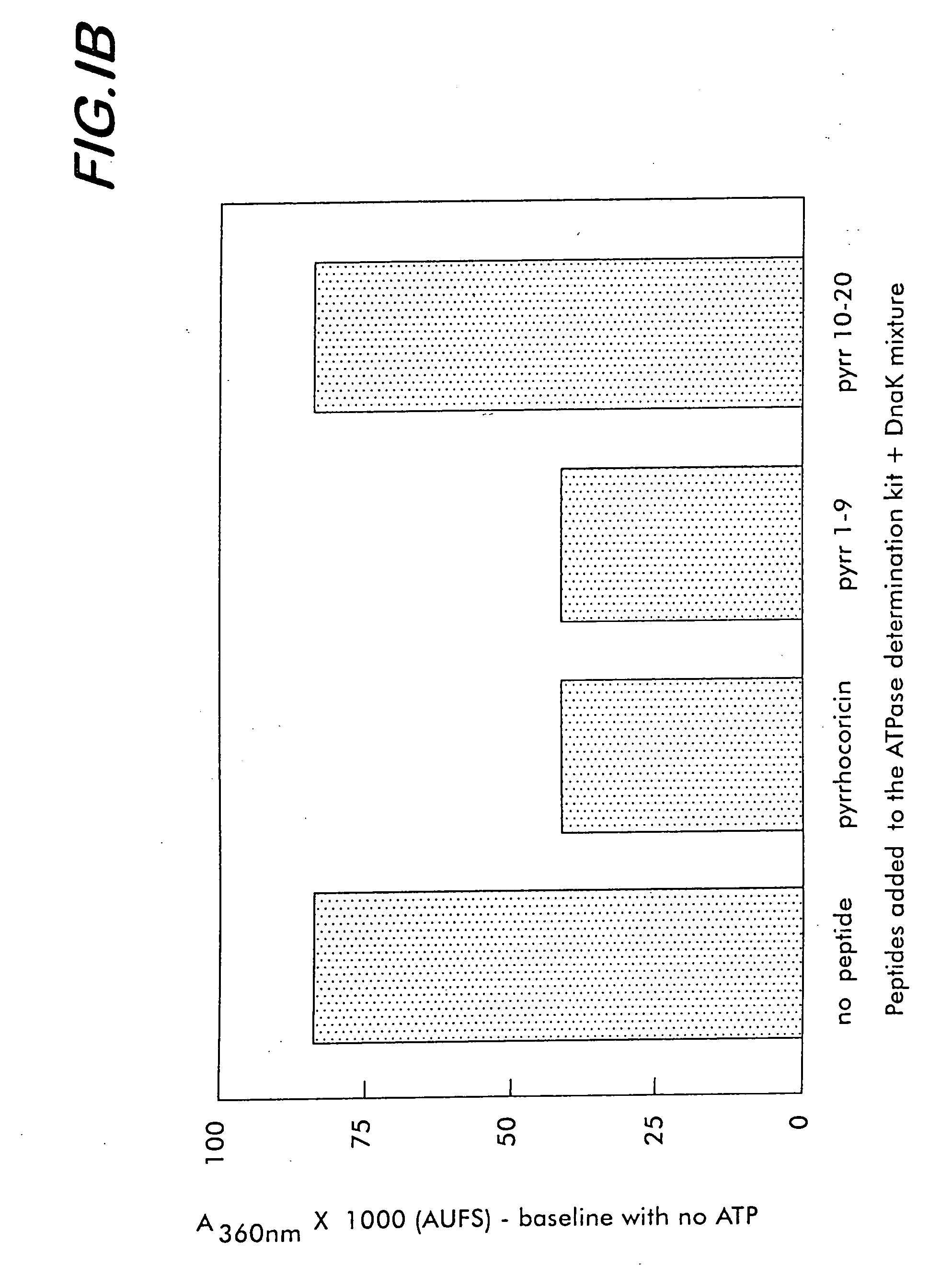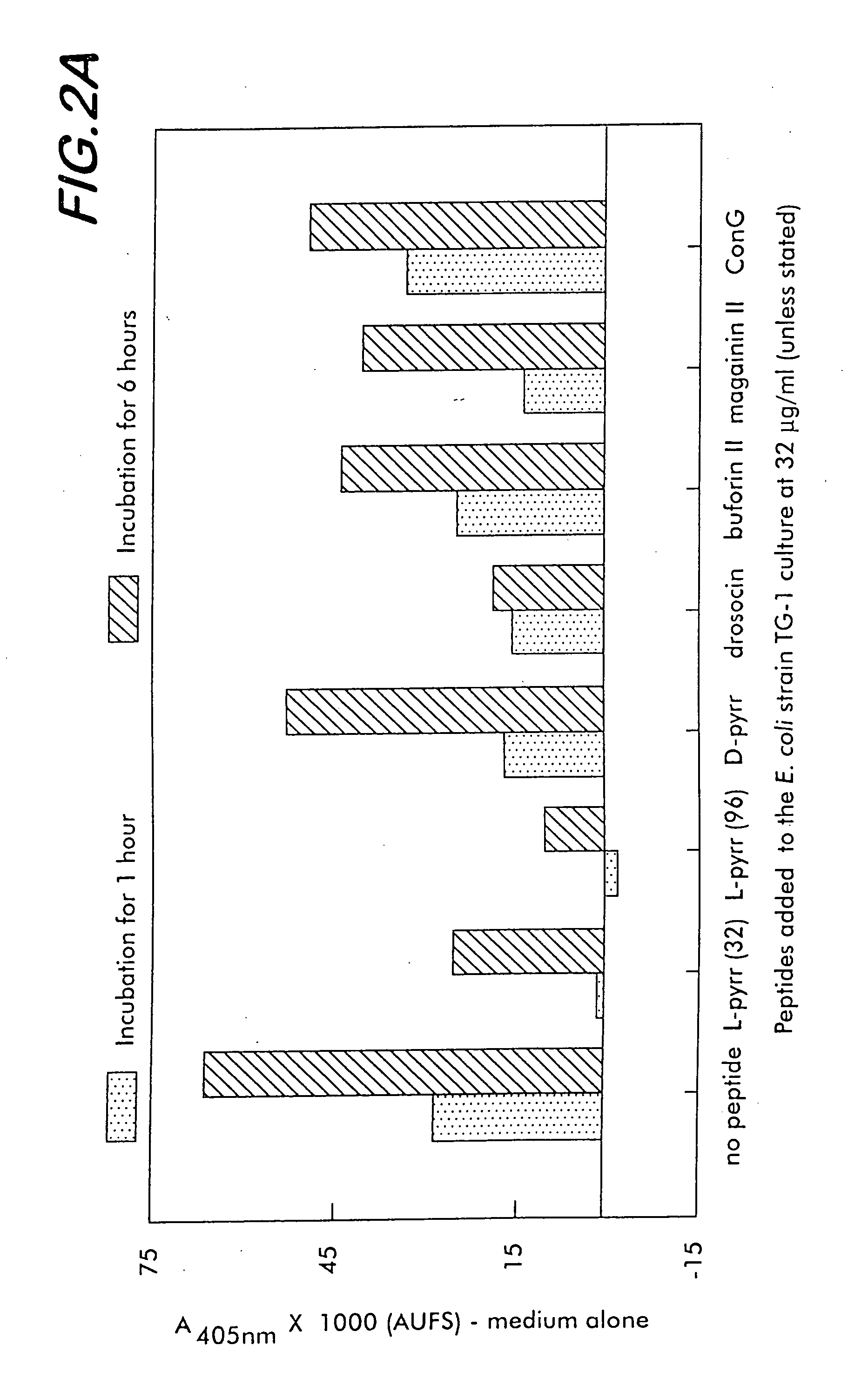Biocidal molecules, macromolecular targets and methods of production and use
- Summary
- Abstract
- Description
- Claims
- Application Information
AI Technical Summary
Benefits of technology
Problems solved by technology
Method used
Image
Examples
example 1
Identification of the Target Protein of Pyrrhocoricin
[0134] The identification of the target protein was accomplished using four primary steps.
[0135] A. Isolation of the Target Protein by Immunoaffinity Chromatography from an E. coli Lysate
[0136] In early assays, it was determined that biotin-K-pyrrhocoricin, a molecule represented by the formula: biotin-Lys-Val-Asp-Lys-Gly-Ser-Tyr-Leu-Pro-Arg-Pro-Thr-Pro-Pro-Arg-Pro-Ile-Tyr-Asn-Arg-Asn [SEQ ID NO: 12], kills E. coli strains (including TG-1, or K-12) in the submicromolar range. Based on this, the target protein was isolated from an E. coli lysate with the help of the labeled peptide, that is useful also to purify the complex through the attached biotin. For this latter purpose, an immobilized anti-biotin antibody was used rather than streptavidin derivatives because of the generally observed lower background with anti-biotin monoclonal antibodies (mAbs). The antigen was detached from the antibody in an acidic buffer, and the resu...
example 2
Strain Specificity of Antibacterial Activity of the Peptides
[0170] Growth inhibition assays are performed using the candidate antibacterial compounds and the Gram positive microorganisms Micrococcus luteus and Bacillus megaterium, and the Gram negative microorganisms, Escherichia coli D22, Agrobacterium tumefaciens, and Salmonella typhimurium. Antibacterial assays are performed in sterilized 96-well plates (Nunc F96 microtiter plates) with a final volume of 100 μl as described in Bulet (1996), cited above. Briefly, 90 μl of a suspension of a midlogarithmic phase bacterial culture at an initial 600 nm UV absorbance of 0.001 in Luria-Bertani rich nutrient medium is added to 10 μl of serially diluted candidate compounds in sterilized water. The final compound concentrations range between 0.15 and 80 μM, and more preferably between 0.3 μM and 40 μM. The plates are incubated at 30° C. for 24 hours with gentle shaking, and the growth inhibition is measured by recording the increase of th...
example 3
The Affinity of Antibacterial Proteins for Heat Shock Proteins
[0175] To characterize the affinity of various bacterial and mammalian heat shock proteins (as well as lipopolysaccharides originated from a large range of Gram-negative bacteria) for pyrrhocoricin, and for analog natural peptides such as drosocin, apidaecin and formaecin, the following steps are taken. The peptide-binding site(s) of DnaK are identified by using chemically synthesized fragments of the protein. The DnaK fragments are made individually by conventional chemical synthetic techniques. In an array format, the peptides are contacted with fluorescein- and biotin-labeled pyrrhocoricin and the amounts of pyrrhocoricin that bind the arrays, respectively, are measured by detection of the amount of label. To pinpoint potential peptide- or bacterial strain-dependent variations of the receptor, biotin-labeled peptide derivatives are used to isolate and characterize the target ‘receptor’ heat shock proteins from various...
PUM
| Property | Measurement | Unit |
|---|---|---|
| Fraction | aaaaa | aaaaa |
| Fraction | aaaaa | aaaaa |
| Inhibition | aaaaa | aaaaa |
Abstract
Description
Claims
Application Information
 Login to View More
Login to View More - R&D
- Intellectual Property
- Life Sciences
- Materials
- Tech Scout
- Unparalleled Data Quality
- Higher Quality Content
- 60% Fewer Hallucinations
Browse by: Latest US Patents, China's latest patents, Technical Efficacy Thesaurus, Application Domain, Technology Topic, Popular Technical Reports.
© 2025 PatSnap. All rights reserved.Legal|Privacy policy|Modern Slavery Act Transparency Statement|Sitemap|About US| Contact US: help@patsnap.com



